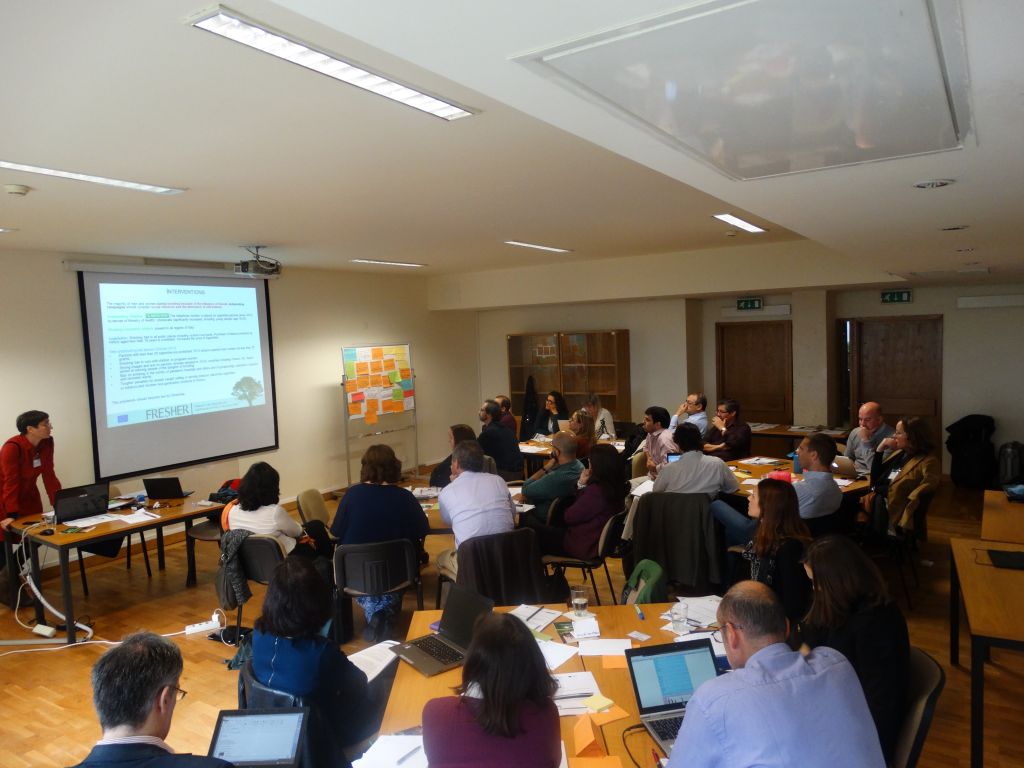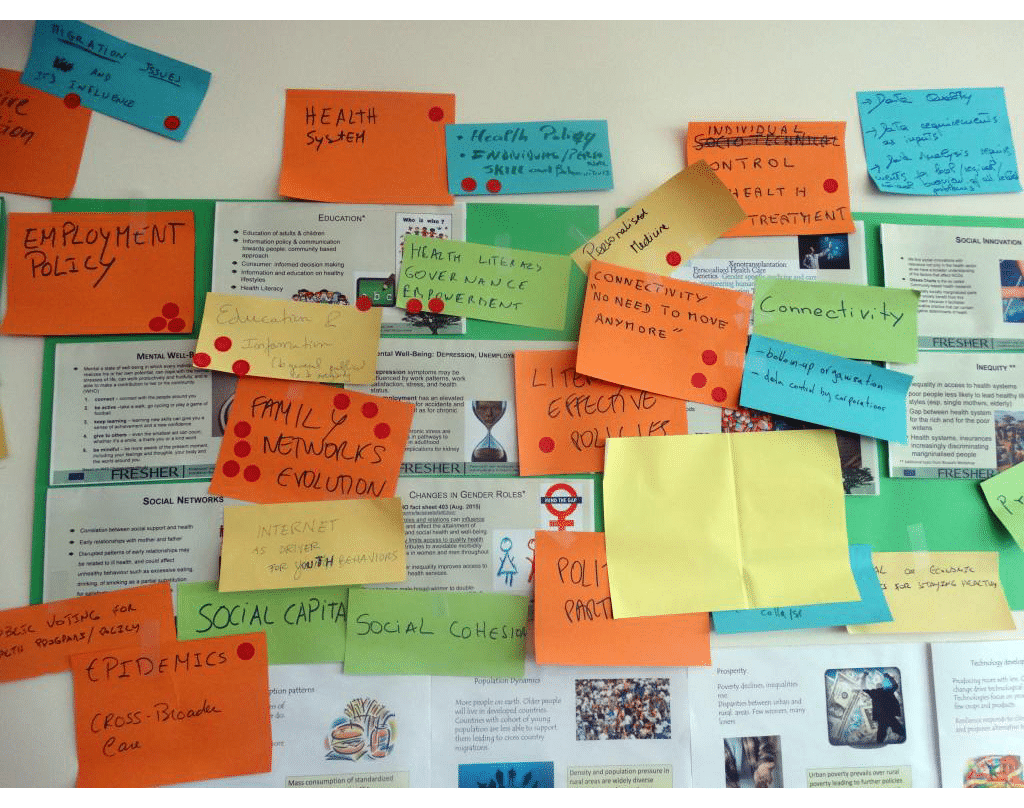
Building FRESHER Scenarios is a systematic and creative process that will engage you in the first step of”Horizon Scanning”. The Horizon Scanning aims at the identification of the NCDs related short, medium and long-term trends and drivers. To complement the literature review on well-researched risk factors, three regional workshops (Vienna, Brussels, Lisbon) are organised to elicit stakeholder’s credible observations about possible changes, wider correlations and potential indications of new emerging issues. By March 2015, the results of these consultations will be included in the FRESHER report “Horizon Scanning” that will be delivered to EU stakeholders, circulated among all participants and discussed in the FRESHER High Policy Event.
The final agenda and the power points, as presented below, provides an overview of the various sessions and topics addressed on third workshop in Lisbon of October 26th, 2015. A full report with the agenda, the participant list and the work proceeding is available here.
A look forward by Susanne Giesecke – Austrian Institute of Technology
Susanne Giesecke opened the workshop asking the following question “Out of context of your work, what do you expect for health and well-being and the differences southern/northern countries?”.Each workshop participant highlighted what will be in his/her view the main challenges and opportunities for the future health and well-being.
Intro to FRESHER Project by Maria Smirnova – European Public Health Alliance Organisation
Maria Smirnova introduced the objectives, the team and methodologies of the FRESHER project, based on an overall approach integrating qualitative and quantitative methods. The project foundation is oriented by Scenario narrative, which is integrated to micro modelling simulation tool. The circle is closed by the elaboration of the policy recommendations (back casting).
Outlook on FRESHER Scenario Building Exercise by Giovanna Giuffrè – Institute of Studies for the Integration of Systems
Giovanna Giuffrè offered an overviewof foresight activities goals and methods. She presented then the FRESHER Scenarios Building aims, steps, timing and main features. To conclude, Giovanna invited the stakeholders to follow up the FRESHER Scenario development and to participate at FRESHER survey that will be launch by May 2016.
Tabacco and Alcohol: risks factors and foresight by Renata Solimini – Istituto Superiore di Sanità
Renata Solimini presented the trends related to tobacco and alcohol use and reviewed the recentEuropean policies and initiatives regarding those two risks factors. Shefocused the attention on the differences the Italy and Mediterranean prospective versus Nordic countries in drinking behaviours.
Diet and physical activity: risk factors and foresight by Paulo Nicola– consultant to the Portuguese Ministry of Health
Paulo Nicola introduced firstly the key concepts in health promotion and primary prevention and presented the results of the recent foresight work on “Tackling Obesities: Future Choices – Building the Obesity System Map”. He then offered a comprehensive analysis of trends of risk factors, drivers and determinants related to phisical activities and diet. Paulo Nicola reviewed the current policies and targets addressing phisical activity and diet highlighting some best practices, the key differences among european countries and the critical issues at stake.
The futures of agriculture, food and rural development: Drivers and scenarios by Robin Bourgeois Global Forum on Agricultural Research GFAR c/o FAO-DDNG
Robin Bourgeois concluded the first session by reflecting on the future of agriculture, food and rural development. Starting from eight trends, drivers and disruptions namely Globalization, Connectivity, and Consumption patterns, Resources, Population dynamics, Urbanization Technology development, Prosperity, Robin Bourgeois showed eight plausible Scenarios on what the future of agriculture may be.
The following three working groups were formed on the drivers ranked as most important by the workshop participants:
- Inequity/prosperity & economic governance
- The evolution of family networks / Education and information
- Urbanisation, land use and territorial cohesion
- Consumption patters
The discussion of the working groups are briefly summarized below:
The evolution of family networks / Education and information (general public, the internet as a driver for youth behavior)
The group recognised a rising trend of improved “intergenerational” communication and a change from the traditional nuclear family to a post-modern ‘tribe’ built on the sharing of common interests and enabled by social networks. In the future, ‘ad hoc’ families/unions can be created for temporary interests and with no long-term engagement. The educative and health model will move outside the spheres of families and schools: social networks will predominate. People with NCDs will look for support and information on the networks and will be influenced by the models and solutions provided by social media. Indicators of this shift is the time spent on the internet within the families and the increased use of social networks for different objectives. Key assumptions for this trend are: 1) The continuous investment in ICT technologies and the increase in connection capacity 2) Changes in work patterns with a higher employment rate for women and increased work mobility. The drivers of these changes are the increased availability of virtual communication and extended life expectancy whereas economic, religious and industrial beliefs/interests and logistic difficulties (costs) act as challenge on the evolution of the family network.
Inequity/prosperity & economic governance
The group considered how the EU economic crisis has put an halt to the increase in health expenditures in years when the needs were rising (due especially to unemployment). However, the group pointed out the opportunities of governments to improve the organisation and the allocation of resources in order to ensure the accessibility and quality of services. Participants discussed the linkages between health and health spending with the economic growth/crisis and identified long-term unemployment as one of the possible high risks for the life and health of future citizens. Among other future risks mentioned were: the ageing of the population, the possible limitations of social security systems, possible bankruptcies and the work market revolution. In the future, a ‘decorporatization’ of healthcare (e.g corporations selling pension plans) is possible. If corporations withdrawal from their central role (in welfare, this was initially based on industrialization), this will require governments and individuals to assume a new role. Governments could become more controlling and citizens more aware and informed. These changes could lead to the establishment of a new social contract among citizens/government or to social unrest/war. Some indicators of this shift are the approximations of health laws and procedures within the EU and the emergence of European solidarity. Key assumptions for this trend are 1) technology is good; 2) European integration is on the rise; and 3) people are working less. The drivers of this change include the role of technology in shaping job creation as well as its role in job destruction. The vision imagined takes population dynamics, such as aging and migration, into consideration. Energy and its role in economic growth also plays an important role. Some inhibitors of change toward different society setting are the inertia and resistance of institutions as well as current regulations and norms (e.g. current laws regarding labour mobility).
Urbanisation, land use and territorial cohesion
The group discussed two opposing trends with regard to urbanisation: the re-urbanisation of the inner cities promoted by different local governments and the long-standing trend of urban sprawl. City sprawl is strongly linked with the costs of the land, the provision of services (i.e. transport) and city life – new neighbourhoods built without planning, particularly regarding social cohesion, risk leading to the polarisation and the fragmentation of the city’s population. Participants of the workshop imagine a future in which healthy and compact cities play a key role in the health and well-being of Europe’s populations. Among the positive impacts mentioned: greater social, environmental and economic sustainability, the revitalisation of neighbourhood life, the creation of walkable paths to everyday services, a decrease in maintenance costs, and a consequent decrease in pollution. At the global level, healthy cities would contribute to 1) improved energy and water efficiency 2) the promotion of sustainable mobility 3) an increase in solidarity and social cohesion. However, these prospective changes require a shift in the role of construction industries after the economic crisis. An economic recovery plan driven by a ‘business as usual’ construction industry risks expanding the sprawl and city fragmentation. Examples or seeds of the trend toward sustainable cities today are the initiatives of ‘real’ sharing economies, neighbourhood organisation for local consumption and social support initiatives. The drivers of these trends may be improved connectivity, the revision of land-use policy in the prospective of sustainability, the considerations of local governments for cost/benefit analysis, the emergence of a nexus among environmental, health and equity policies. The group recognised as challenge of this trend to develop: the lack of multi-level governance at the metropolitan level; the lack of inter-sectoral collaboration at the local, metropolitan and national level; and austerity measures.
Consumption patterns
The group recognised the increased awareness among EU citizens of the impact of diet and alcohol on health as well as a growing attention of governments on promoting healthy food and behaviours. At 2050, the group imagined two opposite visions. In a vision, citizens achieve a work-life balance, develop ethical concerns on the food sourcing and produce certain foods in the urban environment. Seeds of changes toward this vision are the decrease consumption of alcohol and “visible sugar” and the rise in demand of fresh, semi-processed food. In the second vision, the family patters (more nuclear family) and work schedule (long hours) lead to the increase consumption of fast and convenient food. Higher consumption of “hidden” sugar and salt in processed food represents a risk for diabetes and other NCDs. The workshop participants considered climate change as a key challenge for the future agriculture production and food prices. The group indicated as drivers toward healthy consumption patterns 1) healthy literacy 2) fiscal policy 3) social pressure and pointed out as inhibitors of change 1) the lobby of industries and other sectors as big farmers 2) the trade agreements that endanger regulations that protect health.
